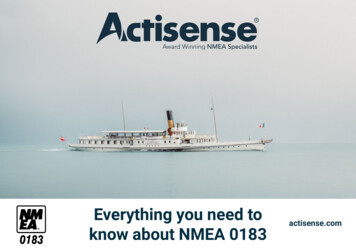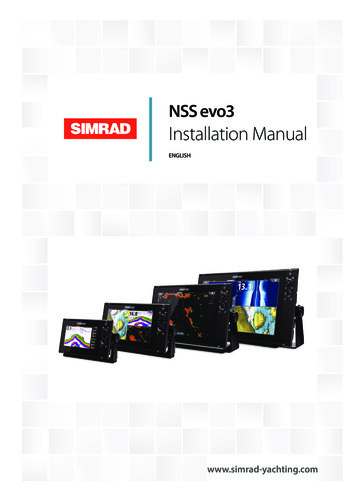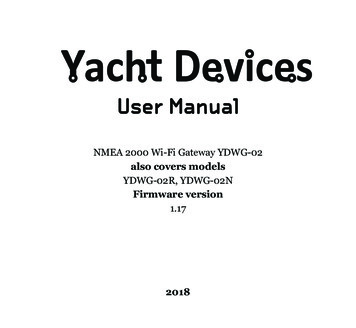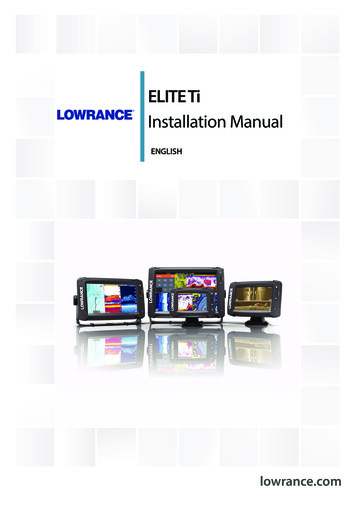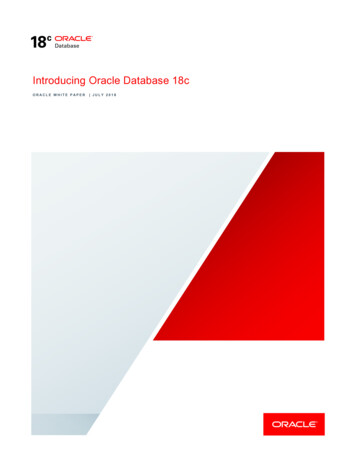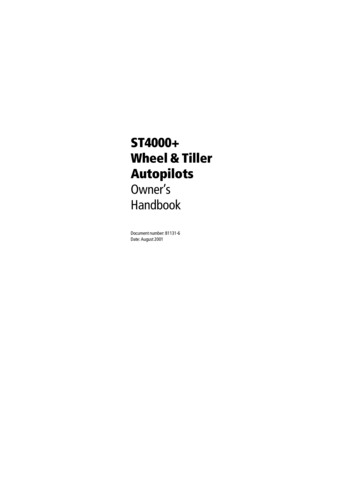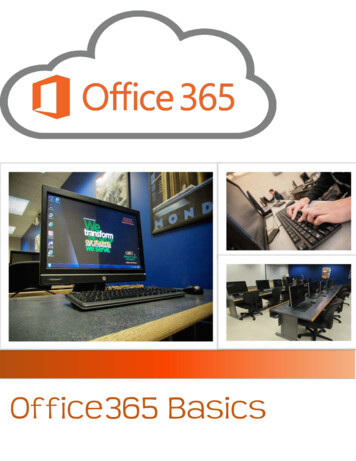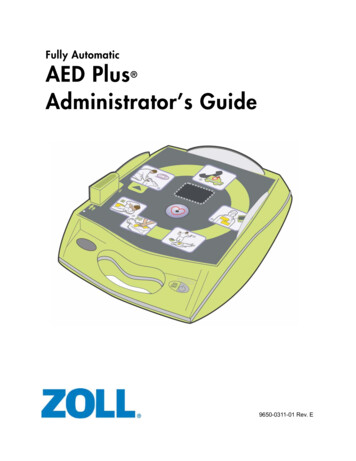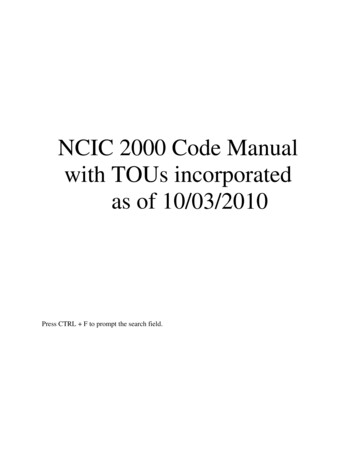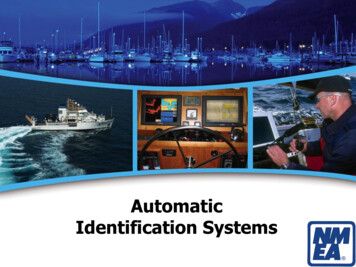
Transcription
AutomaticIdentification Systems(AIS)
What is AIS?An automated autonomous systemfor the exchange of navigationalinformation between suitably equippedvessels and shore stations usingdistinct messages and operating on twodesignated marine VHF channels.
AIS ReportsPort InfoLocal Data(Tides, Current,Weather)Administration(Pilots, BerthAssignments)Ship to ShipAIS ReportsVTSControlCenterDGPSCorrectionsAIS ReportsPort InfoPlus Aids To Navigation and SAR Aircraft
How did we get AIS?International MaritimeOrganization (IMO)
Maritime Safety Committee
ITU: International Telecommunications Union (UN)Frequency Mgmt and ICT Performance StandardsIEC: International Electrotechnical Commission (non-Govt)Standards such as IEC 61162 interfacing protocols andAIS equipment standardIHO: International Hydrographic Organization (Inter-Govt)All matters related to hydrography incl. Chart standardsIALA: International Assoc. of Lighthouse Authorities (non-Govt)Navigational Standards (Aids To Navigation – VTS - AIS!)
NMEA: National Marine Electronics Association(non-Govt)NMEA 0183 and NMEA 2000 protocolsRTCM: Radio Technical Commission for Maritime Services(non-Govt)U.S. Radar Standards for UTVs, FCC EPIRB standards,DGPS interface (SC104)
Why do we need AIS?Creates a much improved situationalawareness for the Navigators byovercoming the inherent limitations ofsight, VHF voice and radar for collisionavoidance – regardless of vessel size
How does AIS work?The heart of the system is atransmission protocol called SelfOrganizing Time Division MultipleAccess (SOTDMA).This protocol is what allows AIS tobe autonomous and continuouslyoperational.
SO-TDMA60 Seconds2250 SlotsAAIS-1AIS-2ABBB26.67 ms1 Slot 256 BitsCCC C .AA.IdentityPositionSpeed over GroundCourse over GroundHeadingRate of TurnNavigation StatusTime Stamp
Due to the anticipation of far morenon-regulated vessels than regulatedvessels, the Maritime Safety Committeecommissioned the technicalorganizations to develop an alternativesystem that we know as Class B.
Class A – Regulated VesselsUses the SOTDMA protocol2- to 10-second Interval while Underway3 Minutes while at AnchorSupplemental Data at 6-minute Intervals12.5 watt transmitterClass B – non-Regulated VesselsUses a CSTDMA protocol which politely interweaveswith Class A transmissions30-second Interval while Underway 2 knots3 Minutes while at AnchorSupplemental Data at 6-minute Intervals2 watt transmitter
SOTDMA60 Seconds2250 SlotsAAIS-1AIS-2ABBB26.67 ms1 Slot 256 BitsCCC C .AA.IdentityPositionSpeed over GroundCourse over GroundHeadingRate of TurnNavigation StatusTime Stamp
AIS Nav Broadcasts Latitude (both Classes)Longitude (both Classes)Speed over Ground (both Classes)Course over Ground (both Classes)Position Accuracy (both Classes)Time Stamp (both Classes)MMSI Number (both Classes)True Heading (A requirement - B only if available)Rate of Turn (class A only)Navigation Status (class A only)DSC receiver fitted Y/N? (Class B only)
AIS Supplemental Broadcasts MMSI (both Classes)Radio Call Sign (both Classes)Name (both Classes)Type of Ship/Cargo (both Classes)Dimensions of Ship (both Classes)Location of Reference Point (both Classes)IMO Number (class A only)Type of Position Fixing Device (class A only)Draught of Ship (class A only)Destination (class A only)ETA at Destination (class A only)Vendor ID (class B only)
InstallationsSN Circular 227
Installation ConsiderationsVHF Antennas and cablingGPS AntennasEquipment InterfacesShip’s Power SourcesPilot Plugs
A very important difference about VHF antennasThe AIS frequencies are on the high end of the VHF-FMband (@ 162 mhz). Because of this, the standard marineVHF antennas are not manufactured for optimumperformance at those frequencies.Use the proper antenna for best performance
VHF Antenna Possibly Integrated GPSAntenna. Main VHFAntenna 6’ Feet from ConductiveObjects Ideally 6’ Directly aboveor below VHF6'MinimumAIS VHFAntenna Otherwise 30’ HorizontalSeparationSN Circular 227
The IMO Safety Nav Circular 227 recommends the useof RG-214 coax which is a double screened coax cable whichhas better shielding capabilities (3% more).As a matterRG-58RG-8 MiniRG-8RG-214of comparison, here are the@ 50 ft3.0 db loss@ 50 ft2.3 db loss@ 50 ft1.2 db loss@ 50 ft1.2 db lossfour common types:50% loss40% loss20% loss20% loss
GPS AntennasThe suggested mounting is one which gives acomplete sky view from 5 degrees above the horizonto 90 degrees (the zenith).SN Circular 227
Interconnection CablingAll interconnection cables used to interface NMEA 0183 inputsfrom external GPS units, Gyrocompasses, Satellite Compasses,Speed Logs, and the like should use shielded pair type cables.
DC voltage drops 3%Class A units: 5 A @ 24 vdc10 awg for 50 ftClass B units: 2 A @ 12 vdc14 awg for 25 ft
For Class A systems, the IMO recommendation SN Circ 227 isthat the unit should be connected to an Emergency Source.For IMO vessels, this means the Emergency Generator to which allthe Communication and Navigation equipment is to beconnected to.In addition, an Supplement to the Recommendation alsorequests that the AIS be connected to a UPS to ensure that theswitchover from Main to Emergency does not shut the AIS down
Required for Class A – Ships on International VoyagesPinSignal1Transmit A4Transmit B5Receive A6Receive B9Shield
Configuration
PreferredDataAcceptableNMEA 0183 Sentence FormatReference DatumDTMPositioning System:Time of Position, Latitude / Longitude, PositionAccuracyGNS,GLLGGA, RMCSpeed over Ground (SOG)VBWVTG, OSD, RMCCourse over Ground (COG)RMCVTG, OSDHeadingHDTOSDRAIM IndicatorGBSRate of Turn (ROT)ROTNMEA Input Sentences for Class A units
Vessel DataMaritime Mobile Service Identity (MMSI) NumberVessel NameVessel Type and Cargo TypeGPS Antenna Location/Reference Position/ DimensionsIMO Number (Class A fittings)Radio Call Sign (if assigned)
Distance (meters)AA0 – 511 m511 m 511 m or GreaterB0 – 511 m511 m 511 m or GreaterC0 – 63 m63 m 63 m or GreaterD0 – 63 m63 m 63 m or GreaterGPS/ReferenceLocationBCD
As the final check of the system, make sure thatyou have entered all the Static informationcorrectly.USCG Alert # 05-10“AIS is only as good as the information providedand exchanged, therefore, users must ensuretheir unit is always in effective operatingcondition and broadcasting accurate information”
Confirm with another vessel or shore stationthat they can receive your vessel’s infocorrectly and that you are seeing othersas well before you leave the vessel.
Take the time to teach the Customer how tooperate the AIS and how to decipher what it istelling the Navigator.Don’t assume they will ‘figure it out’ – especiallywhen they get into the Voyage data fields(destinations, cargo type, etc)Remind them that it is an AID to navigation
w.imo.orgwww.panbo.com
United States Coast GuardOffice of Navigation SystemsProviding navigationsafety information forAmerica’s waterwaysJorge ArroyoProgram AnalystU.S. Coast Guard HeadquartersWashington, DCInternational Boat builders’Exhibition and Conference (IBEX)October 17th, 2011Louisville, KY
Automatic Identification System (AIS) U.S. AIS HistoryRegulations Who? Where? When?AIS UpdateApplication Specific MessagingAIS @ www.navcen.uscg.govQuestions & Answers
AIS History & TimelineWRC’97AIS1 Ch.87BAIS2 Ch.88BSOLASV/19.2.4IMOITU-R M.1371-1MSC 74 (69)TechnicalPerformance2002 IMODiplomaticConferenceSOLASV/19.2.4IEC 61993-2Testing essMarine BoardPorts &WaterwaysStudyVTS LMRPublicMeetingFCCNoticeDA-02-1362MTSA - 11/02Interim - 7/03Final - 10/03Deadline - 1/04
What started the USCG on AIS?In 1990, Congress passed the Oil Pollution Actwhich participation in VTS mandatory anddirected the USCG to seek ways to have‘dependent surveillance’ of all tankers bound forValdez, Alaska.To that end, in 1993 the USCG developedAutomated Dependent Surveillance ShipboardEquipment (ADSSE), based on Digital SelectiveCalling (DSC) protocol.
Congress supports/mandates AIS!In 1997, Congress stated that AIS“technology should be the foundation of anyfuture VTS system” and that it “stronglybelieves that this technology willsignificantly improve navigational safety, notjust in select VTS target ports, butthroughout the navigable waters of theU.S”, and, that we “continue working withstakeholders ”H.R. Rep. No. 236, 105th Cong., 1st Sess. (1997)
Industry endorses AIS!In 1999, the National Dialog Group, comprised of the marineprivate and public representatives, stated they:“strongly endorse the widespread use of AISemploying dGPS and onboard transpondertechnologies that national use of AIS technology onthe greatest number of vessels is essential both as afoundation of a VTS system improving navigationsafety strongly urge the USCG to take the lead indeveloping equipment and procedural standards thatwill promote universal use of AIS technology”, whichwill “be less intrusive and distracting to the marinerthan will a voice-based control system ”
AIS TimelineWRC’97AIS1 Ch.87BAIS2 Ch.88BSOLASV/19.2.4IMOITU-R M.1371-1MSC 74 (69)TechnicalPerformance2002 IMODiplomaticConferenceSOLASV/19.2.4IEC 61993-2Testing essMarine BoardPorts &WaterwaysStudyVTS LMRPublicMeetingFCCNoticeDA-02-1362MTSA - 11/02Interim - 7/03Final - 10/03Deadline - 1/04
Towards an AIS-based VTSIn an effort to facilitate vessel transits, enhancegood order, promote safe navigation, and improveupon existing operating measures on the waterway.The USCG proposed to establish a Vessel TrafficService on the Lower Mississippi River and transfercertain vessel traffic management provisions on theriver.By implementing a proposed transition to VTS in aphased manner which would allow for the orderlytransition from existing regulations and practices tooperating procedures appropriate to an AIS-basedVTS. Ref: 65 FR 24616, Apr. 24, 2000
Mandated by Congress in 2002 Marine Transportation & Security Act of 2002Commercial self-propelled vessels 65 feet orgreater;-- Towing Vessels over 26 feet or greater and 600hp or more;- Passenger vessels as determined by USCG; and- those the USCG deems necessary for safety.
AIS Carriage Regulations 33 CFR 164.46The following must have a properly installed, operational, type-approved AIS On international voyage: Tankers, Passenger 150 GT, all others 300 GT Per SOLAS Regulation V/19.2.4 Self-propelled commercial vessels 65 feet Except fishing and small passenger vessels ( 150 passengers) Within a VTS area: Self-propelled commercial vessel 65 feet Except fishing & small passengers vessels Towing vessel 26 feet and 600 hp Vessel certificated to carry 150 passengers
AIS Rulemaking [Changes in Bold-type]Estimated ExpandedAIS PopulationShips 65ft10/23/03 current AIS requirement published (33 CFR 164.46)Freight Ship298Industrial Ship748MODU210OSV553Research Vessel97School Ship19Tank Ship122Unclassified385Unknown54107/01/03-01/09/04, 3 meetings & comment period re: AIS expansion10/31/05, agenda entry re: expansion of AIS to all navigable waters12/16/08, NPRM published; 04/15/09, comment deadlineProposed compliance date: NLT 7 month after Final Rule(73 FR 78295)AIS prices: Class A, 2,800-5,000; Class B, 700-1,500 Installation cost will vary by display options & interfacingFishing 65ftSOLAS requires interfacing to GPS, THD, ROT, back-up powerPotentially could effect 17,442 vessels/14,506 small biz’s, i.e. 2,973 Commercial self-propelled vessels of 65 feet No exclusions Towing vessels 26 feet and 600 hp Vessels with 50 passengers (vice 150 for hire) Hi-Speed vessels with 12 passengers for hireCertain dredges & floating plants, &Vessel moving certain dangerous cargoes5,520Documented4,571Undocumented (est.)949Towing 26ft & 600hp4,560Passenger3,235 65ft2,167 65' but 50 pax1,062 30kts & 12 pax for hire6Dredges35Total (U.S.)Foreign Flag 65ftTotal (All)16,3231,11917,442
U.S. AIS Carriage PopulationVessel ServiceFishing BoatSOLASIR 7/1/02FR 11/23/03NPRM 12/16/081749-15477772982111117481--210Offshore Supply Vessel55433432553Passenger er-1113385Unknown-1616541Cargo ShipIndustrial VesselMODUTank ShipForeign5,520351,119 65' 300GTTotals4384,1212,96317,442
AIS Certification Standards Update IEC 61993-2 Class A published in 2001-Edition 2 completed – publication 2012 IEC 62287-1 Class B published in 2006-Edition 2 published – 29 Oct 10 IEC 62320-1 AIS base station published in 2007 IEC 62320-2 AIS AtoN base station published in 2008 IEC 61097-14 AIS SART published in 2009-Their use became permissible 1/1/10 IEC 62287-2 Class B SOTDMA-Still in development – publication 2012
AIS SART – GMDSS Search and Rescue AIS TransmitterNEW PRODUCT – Part of GMDSS from Jan. 2010:- Alternative to traditional radar SART, for use in life boats / rafts- Location is automatically shown on electronic chart / ECDIS- Each AIS-SART has a unique code, unlike radar-SART & 121.5, thusmany in the same area will not overload the search system.- Transmit 1 burst of 8 transmissions every minute, using SOTDMA- 1 W ERP output / 96 hours operation
Key West Trials Aviation Results16014020,000 ft12010000 ft5000 ftDetection Range in NM1001000 ft806040200406 EPIRB121.5 HomerRadar SART AAIS EPIRBAIS SARTAIS PLBAIS SART on VESSEL
ITU-R M.1371 AIS Message Descriptions - ApplicationsID#1,2,3Position Reports – autonomous (au), assigned (as), or interrogated (in)AUASINxxxSlots14Base Station Report – UTC/date, position, slot nr.5Class A Report - static and voyage related dataxxx2Binary Message – addressed, acknowledge or broadcastxxx5/2SAR aircraft position reportxxx1UTC/Date - enquiry and responsexx1Safety Text Message – addressed, acknowledge or broadcastxx5/215Interrogation – request for specific messagesxx116Assignment Mode Command17Binary Message – DGNSS Correction6,7,8910,1112,13,14xx1x1x1x2x118,19Class B Reports – position & extended20Data Link Management – reserve slots21ATON Report – position & status22Channel Management23Group Assignment24Class B-CS Static Data25Binary Message - single-slot126Binary Message - multi-slot (STDMA)5xxxxx211x1
Application Specific Message Format
Meteorological & Hydrological Reporting Improves the overall safety & efficiency ofmarine traffic Some in place since 2002
AIS can transfer data via binary messages Provides a means to use other applications Encode application on the transmission side Decode application on the receive side Sent as either General or Addressed broadcast Addressed messages (MMSI-to-MMSI)receives an acknowledgement that the binarymessage was received
IMO SN/Circ.236AIS BINARYGUIDANCE4-YR TRIALPERIODMay 2004 - 2008
IMO SN/Circ.236 ASM’s Met/Hydrological* Dangerous cargo indication* Fairway closed* Tidal window* Extended ship static & voyage-related data* Number of persons on board** VTS-generated/synthetic targets**
IMO SN/Circ.289AIS ASMGUIDANCE22 ASM’s
IMO SN/Circ.289 ASM’s Clearance time to enter port Marine traffic signal Berthing data Weather observation report from ship Area notice – broadcast & addressed Extended ship static and voyage-related data* Dangerous cargo indication* Environmental Data Route information – broadcast & addressed Text description – broadcast & addressed Meteorological and Hydrographic [sensor] data Tidal window
Future ASM developments International Assoc. of Marine Aids to Navigation & Lighthouse Authorities (IALA)Guidelines & Recommendations E-Navigation Committee, Portrayal Working Group Maintaining an AIS ASM catalogueRadio Technical Commission for Maritime Services (RTCM) Standards Special Committee 121 - AIS ASM Special Committee 129 - Navigation Portrayal Special Committee 109 – Electronic Chart Systems U.S. Coast Guard To expand our AIS ASM test beds to Louisville KY and with USACE LOMA effort To expand mandatory AIS carriage to all U.S. waters To require ECS and its integration with AIS (including ASM’s) To provide NOAA PORTS via NAIS
www.e-navigation.nl/asm
Future ASM developments International Assoc. of Marine Aids to Navigation & Lighthouse Authorities (IALA)Guidelines & Recommendations E-Navigation Committee, Portrayal Working Group Maintaining an AIS ASM catalogueRadio Technical Commission for Maritime Services (RTCM) Standards Special Committee 121 - AIS ASM Special Committee 129 - Navigation Portrayal Special Committee 109 – Electronic Chart Systems U.S. Coast Guard To expand our AIS ASM test beds to Louisville KY and with USACE LOMA effort To expand mandatory AIS carriage to all U.S. waters To require ECS and its integration with AIS (including ASM’s) To provide NOAA PORTS via NAIS
NOAA’s
Real-Time PORTS Locations
NOAAP.O.R.T.S.PhysicalOceanographicReal-TimeSystem
AIS ASM NOAA PORTS Portrayal
Future ASM developments International Assoc. of Marine Aids to Navigation & Lighthouse Authorities (IALA)Guidelines & Recommendations E-Navigation Committee, Portrayal Working Group Maintaining an AIS ASM catalogueRadio Technical Commission for Maritime Services (RTCM) Standards Special Committee 121 - AIS ASM Special Committee 129 - Navigation Portrayal Special Committee 109 – Electronic Chart Systems U.S. Coast Guard To expand our AIS ASM test beds to Louisville KY and with USACE LOMA effort To expand mandatory AIS carriage to all U.S. waters To require ECS and its integration with AIS (including ASM’s) To provide NOAA PORTS via NAIS
Meteorological & Hydrological Reporting Improves the overall safety & efficiency ofmarine traffic Some in place since 2002
USACE RTCVReal-timeCurrent - VelocitySystem
Lock Order Used by SaintLawrenceSeaway tesracing & waittime
Area Noticecircle or point(Geo-referenced ed text
Area Notice DescriptionsAnchorage Area: Anchorage closedAnchorage Area: Anchorage openAnchorage Area: Anchoring prohibitedAnchorage Area: Deep draft anchorageAnchorage Area: Shallow draft anchorageAnchorage Area: Vessel transfer operationsCancellation – cancel area per Msg Linkage IDCaution Area: Cluster of fishing vesselsCaution Area: Derelicts (drifting objects)Caution Area: Divers downCaution Area: Dredge operationsCaution Area: Fairway tChartChartCaution Area: Fishery – nets in waterClearance granted – proceed to berthInstruction: Do not proceed beyond this point/junctureCautionCautionCautionCautionDistress Area: Person overboardDistress Area: Pollution response areaDistress Area: SAR areaDistress Area: Vessel abandoning shipOther – Define in associated text fieldProceed to this location – await instructionsReport from ship: Icing infoReport from ship: Miscellaneous informationArea: Harbour closedArea: Marine eventArea: Marine mammals habitatArea: Marine mammals in area – reduce speedFeature: Bridge partially openFeature: Channel obstructionFeature: Reduced vertical clearanceFeature: Semi-submerged objectFeature: Shoal areaFeature: Shoal area due eastFeature: Shoal area due northFeature: Shoal area due southFeature: Shoal area due westFeature: Submerged objectFeature: Sunken vesselEnvironmental Caution Area: High windEnvironmental Caution Area: Storm front (line squall)Environmental Caution Area: Storm warningInformation: Icebreaker waiting areaInformation: Location of response unitsInformation: Pilot boarding positionInformation: Places of refugeInformation: Position of icebreakersInstruction: Await instructions prior to Instruction: Contact Port Administration hereInstruction: Contact VTS at this point/junctureCaution Area: Marine mammals in area – report sightings Distress Area: Vessel collisionRestricted Area: Active military OPAREACaution Area: Marine mammals in area – stay clearRestricted Area: Drifting MinesDistress Area: Vessel disabled and adriftCaution Area: Protected habitat – no fishing or anchoring Distress Area: Vessel fire/explosionRestricted Area: Entry approval required prior to transitCaution Area: Protected habitat – reduce speedCaution Area: Protected habitat – stay clearCaution Area: Risk (define in Associated text field)Distress Area: Vessel floodingDistress Area: Vessel groundingDistress Area: Vessel listing/capsizingRestricted Area: Entry prohibitedRestricted Area: Firing – danger area.Restricted Area: Fishing prohibitedCaution Area: Seaplane operationsDistress Area: Vessel requests medical assistanceRestricted Area: No anchoring.Caution Area: Survey operationsCaution Area: Swim areaCaution Area: Traffic congestionCaution Area: Underwater operationCaution Area: Underwater vehicle operationChart Feature: Bridge closedChart Feature: Bridge fully openDistress Area: Vessel sinkingDistress Area: Vessel under assaultEnvironmental Caution Area: Heavy icingEnvironmental Caution Area: Restricted visibilityEnvironmental Caution Area: Strong currentsEnvironmental Caution Area: Hazardous sea iceEnvironmental Caution Area: High wavesRouge or suspicious vesselRoute: Alternative routeRoute: Recommended routeRoute: Recommended route through iceSecurity Alert – Level 1/2/3Vessel requesting non-distress assistanceVTS active target
www.navcen.uscg.gov
www.navcen.uscg.gov
www.navcen.uscg.gov
AIS Class A & BComparisonClass AClass B/CSTransmit Power2w12.5w / 2w (low-power)Reporting Rate2 - 10 sec - speed and/or course dependent30 sec. fixedCommunicationProtocolSO-TDMASelf-Organizing amongst Class A'sCS-TDMACarrier-Sense(s), polite to Class A’sFrequency Range &Bandwidth156.025 -162.025 MHz @ 12/25 kHzDSC Required161.500 - 162.025 MHz @ 25 kHzDSC & 12.5 kHz OptionalPosition SourceExternal GNSS & Internal GPSInternal GPSDigital Interfaces2 Input-Output Ports & Multiple OutputsOptionalDisplayMultiple Keyboard Display (MKD)OptionalSafety TextMessagingReceive & TransmitTransmit Optional & Pre-configuredDataAllNo Rate of Turn, Navigation Status,Destination, ETA, Draft, IMO#CG Type-Approvals22 Models - 16 Manufacturers8 Models - 8 ManufacturersApproximate Cost 2,800 - 4,000 700 - 1,500
www.navcen.uscg.gov
www.navcen.uscg.gov
www.navcen.uscg.gov
www.navcen.uscg.gov
www.navcen.uscg.gov
www.navcen.uscg.gov
USCGAISReportFormwww.navcen.uscg.gov via ‘Contact Us’ tab
Ship to Ship AIS Reports AIS Reports VTS Control Center Port Info Port Info Local Data (Tides, Current, Weather) . USCG Alert # 05-10 "AIS is only as good as the information provided and exchanged, therefore, users must ensure . Marine Transportation & Security Act of 2002 - Commercial self-propelled vessels 65 feet or
